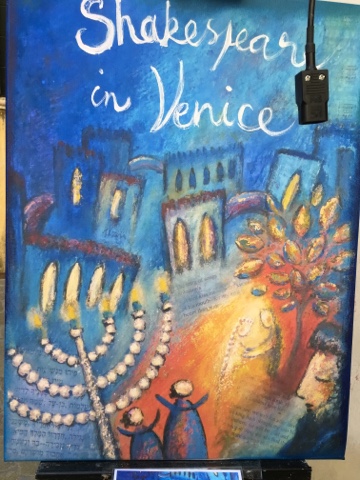Last October Karen was visiting Venice and heard that in celebration of the 500th anniversary of the Venice ghetto and the 400th anniversary of Shakespeare's birth, the Merchant of Venice would be performed outdoors at the Venice Ghetto in English. Besides a number of related activities, Ruth Bader Ginsberg would preside at a mock trial of Shylock, Antonio and Portia. Certainly a very tempting proposition. Then we discovered MIT's humanities department was intimately involved along with PBS, the BBC, Columbia and Ca’ Foscari University. How could we miss this?
Landing in Venice is in itself a special experience. Flying over the Adriatic Sea in preparation for landing on the last piece of the mainland that will link you to this magical city of islands, you approach looking down on farmland that turns into lacy appearing lagoons and ultimately the islands that comprise Venice.
We stayed at Ca' Sagredo along the Grand Canal in the Cannaregio area, close to the Ghetto Nuevo in the northwest part of Venice and a good 15 minute walk from the crowds of St. Mark's square. What a magnificent hotel and convenient venue just far enough away from the stifling crowds.
The performance was an insightful and unique interpretation by Ca’ Foscari University. We did our homework beforehand both reading the text and watching the Al Pacine, Jeremy Irons version on DVD - highly recommended. The story is often thought to reflect negatively on people of Jewish heritage. However, particularly seen through the lens of today's xenophobic events, it begs the question if Shakespeare was in fact thinking about how those that are thought of as "different" are perceived and unfairly treated.
Steve had his moment with Supreme Court Justice Ginsberg. They compared notes on her time at Harvard Law School as one of the first female students, along with Steve's cousin.
 The trial with the US Ambassadir to Italy, along with three other Italian and US dignitaries or academics as judges, three as prosecutors and two as commentariats had everyone on the edge of their seat. We won't tell you the judges' decision, you can get that from bthe New York Times, but we will say the event was as memorable as the play.
The trial with the US Ambassadir to Italy, along with three other Italian and US dignitaries or academics as judges, three as prosecutors and two as commentariats had everyone on the edge of their seat. We won't tell you the judges' decision, you can get that from bthe New York Times, but we will say the event was as memorable as the play. A tour of three of the original remaining synagogues still used today was incredibly interesting, along with explanations of the ghetto's evolution. Jewish people found Venice and the surrounding area as a relatively safe haven from persecution as early as the 13th century. The Ghetto, which means foundary, was an area where scrap ores had been kept. At the time, the then powerful city of Venice was encouraging immigration and welcomed the Jewish people. In the 16th century, the Ghetto was a mutually agreed upon area between the Jewish community and the Italin government. It created a safe haven for the much persecuted Jewish people from the rest of Europe. Jewish people were restricted in their profession so as not to compete with Italians. They were locked in behind the Ghetto's gates after nightfall, which served both parties. It's doors were permanently opened by Napolean in 1747, when there were as many as 5,000 living here. Today there are less than 400 Venetsin Jews.
Our group of six MIT event sponsors enjoyed a private tour of the Guggenheim, which even Steve found interesting. Peggy Guggenheim was an orphan of the Titanic, Jewish and a woman ahead of her time who marched to the tune of a different drummer. She famously purchased more than one art piece per day to protect the art from possible destruction by the Nazis.
The Dodge's Apartment Palazzo Ducale's fantastic exhibit "Venice the Jews and Europe 1516 to 2016". The content, technology and insight was superb.
In all we had a fantastic time and met wonderful people. We learned a tremendous amount and are grateful to all those who conceived and executed this anniversary event. We would do it again in a second!








No comments:
Post a Comment